Abstract
The paper is concerned with the problem of additional currents under unbalanced loads. Additional negative- and zero-sequence current components (except for the positive sequence current) flow through phase wires of a three-phase system while the neutral wire carries three zero-sequence currents. This causes both the unaccounted power losses that exceed the cost of similar losses under balanced loads many times, and, which is very important, additional heating of conductor material. This in turn greatly increases heat losses from the conductor surface, which leads to single-phase and multiphase short circuits in the cable electrical networks with neutral conductor. Moreover, these short circuits cause not only electrical equipment failure but also, which is of great concern, fires accompanied by deaths and traumatism of people and considerable material damage. The paper is focused on the fact that the unbalanced load in electrical networks with that of neutral is an objective phenomenon. Therefore, the only effective way to minimize additional power losses and reduce fire hazard is to use special shunt balancers with automated control of their parameters.
Keywords: Unbalanced of currentsadditional loadsfire riskpower loss increase factor
Introduction
Currently, the design of interior wiring in residential and production premises is based on four-core and five-core cables with three phase conductors and one neutral or three phase conductors and one neutral and one grounding conductor. Until now, this has been done based on the assumption that the single-phase loads are balanced in three-phase systems, and geometrically, the sum of currents in the neutral conductor equals zero. However, this does not categorically correspond to reality, since in real operation conditions of household electric devices there is always considerable unbalance of phase currents. There are three main kinds of such unbalance:
Problem Statement
Additional heat losses and their impact on the cable core insulation
Additional power losses in the network caused by unbalanced current are characterized by power loss increase factor :
where - power losses in the network under unbalanced conditions; - power losses in the network, caused by positive-sequence currents; - negative-sequence current unbalance factor; - zero-sequence current unbalance factor; , – zero-sequence resistance and positive-sequence resistance, respectively.
For a three-phase four-wire line, as it is noted in F.D. Kosoukhov's work we will have (Kosoukhov, 1988):
where , – active resistance of neutral and phase conductors of the line.
With the same cross-section of phase and neutral conductors of a 0.38 kV overhead line, the ratio for the line is
. Then expression (
Consequently, value is more affected by factor , whereas factor has much lesser influence on it.. Thus, if under the conditions of uniform electricity consumption (under the same load of phases) the neutral conductor temperature is not high, then under unbalanced currents in the neutral conductor there will be a current of considerable magnitude equal to three zero-sequence currents, which will greatly increase the power loss factor.
Impact of an insulated conductor heating temperature on the insulation quality
The installation of indoor wiring tends to upset the uniform distribution of single-phase loads, and probabilistic unbalance of currents leads to even greater additional heat losses. Normally, the indoor electric wiring is installed with the cables that have polyethylene insulation and aluminum cores with a cross-section from 1.5 mm2 (lighting networks) to 2.5 mm2 (socket network). According to (Wires and cables for electrical units on nominal stress up to 450/750 B inclusive, 2010; Rule of Devices of Electroinstallations (RDE), 2000), the admissible current for buried wiring does not exceed 14-20 A. However, the admissible current is the maximum current that can be carried by the conductor with a set cross-section, provided that the admissible temperature is not exceeded, i.e. for the balanced conditions. Cross section of the conductor should not exceed the established temperature. This means that the cross-section is selected when performing a condition KP =1. However, the cross-section is always selected disregarding the zero-sequence flows in the neutral conductor in the 0.38 kV network. Thus, first of all, the cross-section of the chosen conductor is artificially underestimated, and secondly the rated parameters of the automatic the device protecting the line will also be chosen improperly since it is also selected based on the working current. Since the cross-section of the neutral conductor is not larger (and sometimes even smaller) than the cross-section of the phase conductor, the flowing three zero-sequence currents overheat the insulation which results in its melting and causes a single-phase short circuit. In the event that the automatic circuit breaker in the main section of the network is selected inappropriately (i.e. it is not checked for operation sensitivity under minimum short circuit conditions), the protection device fails to operate in case of a short circuit in some remote part of the network. As a result, fires take place in individual houses in rural populated settlements, cottage areas, urban flats, and in production rooms. The carried-out analysis of literature on the fire, shows that their main reasons are overloads and short circuits (Ward, 2015; Jesse, 2015; Zalok, Hadjisophocleous & Lougheed, 2009; Marxsen, 2017; Clapa, 2015; Walters & Hastings, 1998; Tsui & Chow, 2004; Hadjisophocleous & Chen 2010; Baratov, 1997; Harmon, 2017). However, none of the sources has ever considered the overload of a neutral conductor due to unbalanced phase currents as a cause for these conditions. Moreover, it is worth noting that the developed measures, methods and technical for decrease in asymmetry of currentse have never been considered as a tool for prevention of fires. Therefore, we are the first to suggest the use of balancers as a way to stabilize fire-hazardous conditions.
Research Questions
To achieve the goal of the research, it is necessary to solve the following
Purpose of the Study
Research Methods
The main method for the research is the method of symmetrical components which was applied to devise an algorithm and a program for calculation of additional power losses. Their use enabled experimental research in operating 0.38 kV electrical networks.
Findings
Experimental research of unbalanced conditions in operating 0.38 kV electrical networks
Over many years, we have been involved in the research into unbalanced conditions of distribution 0.38 kV networks in Leningrad and Irkutsk regions, Germany and Mongolia. More than 30 years, we have studied the unbalanced conditions in the outgoing transmission lines of a great number of rural transformer substations, what was noted in our publications for this period (Kosoukhov, 1988; Kosoukhov, 1985; Naumov, 2001; Naumov, Horenkamp & Schulz 2005; Damdinsuren, 2016). To exemplify, we can present some data on the results of measurements and calculations, for the Irkutsk region on one of the transformer substations with 4 outgoing transmission lines supplying residential-commercial load. The research was being done all the year round: in winter, spring, summer and autumn.
Based on an analysis of the data only for one (the first) outgoing transmission line, we can state the following. In winter, the value of the neutral conductor current in this line is 21.3 percent higher than the mean value of the currents in three phases. In spring, it is 26 percent higher; in summer, it is 35 percent lower, and in autumn – 30 percent lower. On the whole for the year, however, the value of neutral current is 8.1 percent lower than the mean value of current in the three-phase system, i.e. only by 1.3A. At the same time, an average value of the power loss factor for the same transmission line was 2.06, i.e. power losses under unbalanced operation of the transmission line exceeded the corresponding losses under balanced operation more than two times. Consequently, the value of the neutral conductor current in the conditions of sufficient current unbalance is comparable with the average value of current in the three-phase system.
Thus, a considerable increase in the neutral current of indoor cable wirings with the neutral conductor can be one of the main reasons for the fires in residential and industrial premises, posing a threat to the lives of people and animals.
An analysis of fires dynamics in the Irkutsk region
Let's pass to the analysis of the causes of the fires in the Irkutsk region. The analysis is carried out during 2000-2014 in the cities and rural settlements. On the published data of Head department of the Ministry of Emergency situations on the Irkutsk region (MDC Prevention of fire spreading, 1997). and also according to the data of Chief Administration of the Ministry of Emergency Situations of the Russian Federation in the Irkutsk region (Information letter of Chief Directorate of the MES for the Irkutsk region, 2014), “the total of the fires made 70246”, as shown in Figure

Change of the number of fires for a cause of infringement of Rules is presented in figures
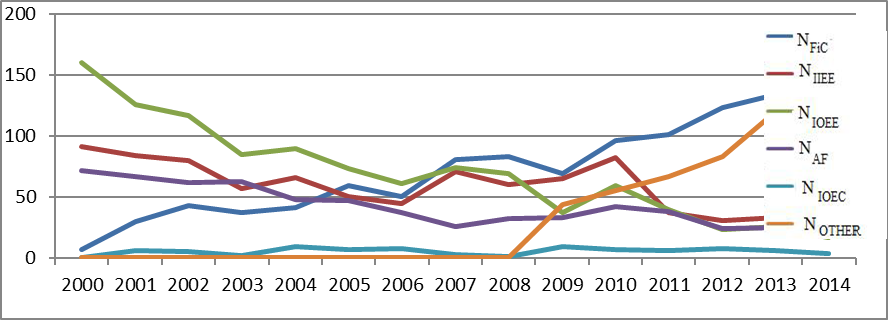
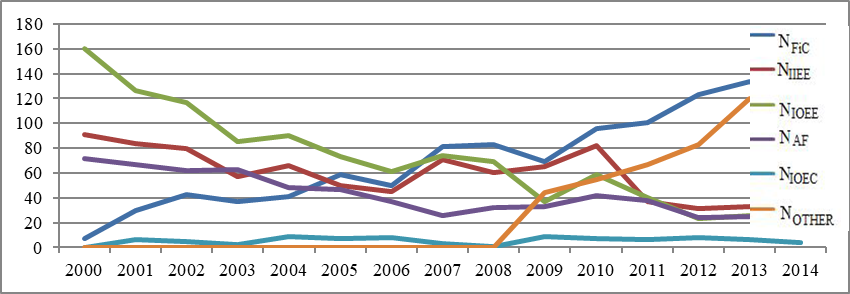
In the submitted figures (
The analysis of the submitted charts on figure
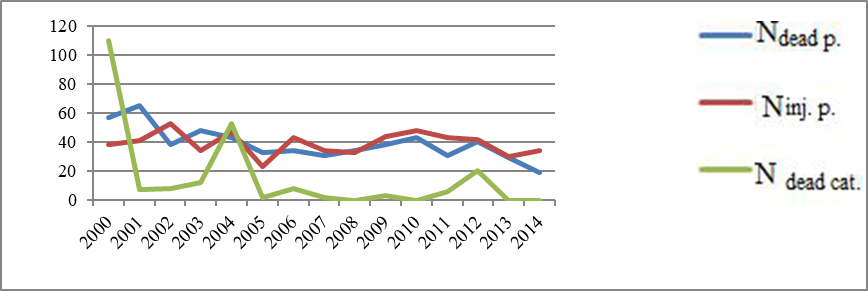

Apparently from the submitted charts, in the cities died and it is injured, respectively 583 and 774 persons, in rural areas 343 persons died, 187 people were traumatized. Besides, the number of the dead of animals in the cities and rural areas, was 231 and 262 respectively. As is seen from the analysis, the fires that occurred during the studied period led to drastic consequences: deaths of people and animals, and considerable material damage. Besides, the arising fires result in significant material damage. Apparently for a cause of infringement of "Rules" in city and rural settlements the material damage was the fires of figure
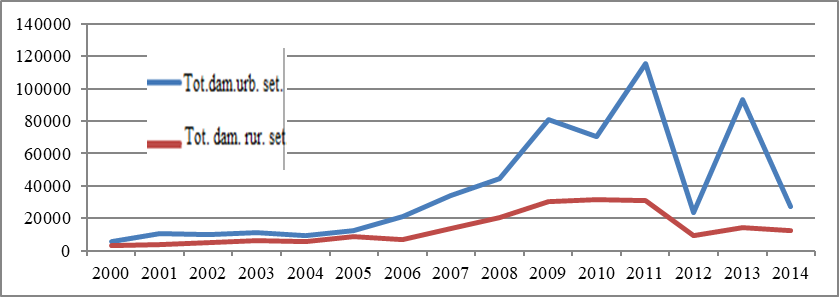
Development of the express balancing device
Our analysis of literature sources confirmed that one of the dangerous manifestations of electric current, from the standpoint of fire danger, is certainly its thermal effect. Conductors that draw the current exceeding the rated value begin to overheat. This can lead to an increase in temperature leading to ignition of the insulation, which can cause a fire. The temperature of the conductive core depends on the strength of the flowing current, the ambient temperature, the core diameter and conductor insulation, heat exchange with the environment, the resistivity of the conductor material, and the time of emergency operation. Moreover, none of the sources considers the overloading of the neutral conductor due to unbalanced phase currents as a cause of overload and short-circuit conditions. Along with this, any overloading leading to additional overheating of insulation in intra-apartment or in-house electrical networks and corresponding short-circuits are undoubtedly connected with the current increase in the neutral conductor. Therefore, the development of methods and technologies for balancing the operating conditions of electrical networks that feed the household load and their application in such networks will be the most effective way of preventing fires.
The main principle of this type of shunt-balancing device is the automatic control of its parameters in the function of the zero-sequence current. Each block of this device has the minimum resistance to the zero-sequence currents, which allows the zero-sequence currents to be closed in the section between the unbalanced load and the device connection place.
The use of balancing devices is a real way to reduce fire hazards because of a decrease in the power flows of zero sequence at the phase current unbalance (Naumov, 2001). Their installation at the incoming switchgears of the urban and rural premises will considerably decrease a power loss factor and, hence, prevent the most severe fire consequences. Thus, a decrease in the zero sequence currents flowing through the neutral conductor will make it possible to substantially reduce the power loss factor and decrease the probability of fire to a great extent. To achieve this, we propose using a balancing device with controlled parameters. The device can both decrease phase current unbalance and control zero sequence flows and, hence, minimize energy losses in the device itself in the conditions of minimum current unbalance (Naumov, Ivanov, Podiyachikh, & Shpak, 2007).
A balancing device (Fig,
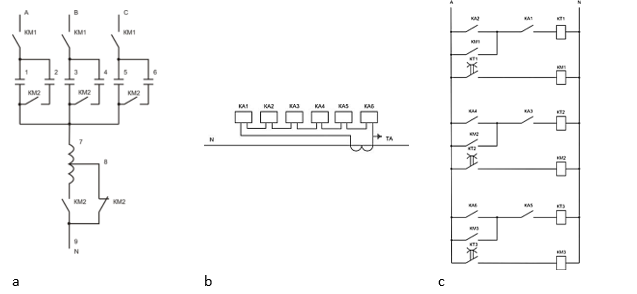
Conclusion
-
Fires in residential buildings are largely related to the violation of the Rules for design and operation of electrical plants.
-
The main reason why fires occur in these buildings is a considerable increase in the current in the neutral conductor, which is due to the unbalance of the phase currents. This leads to an increase in heat losses caused by the neutral conductor overload, the single-phase short circuits, and, accordingly, to the occurrence of fire.
-
The most effective way to cope with the unbalance of currents in the in-house electrical network is the use of special shunt-balancing devices with automatic control of their parameters.
References
- Baratov, A. (1997). Standardizing industrial fire and explosion Hazards in Russia. Fire Technology, 3, 254-259.
- Clapa, I. (2015). Fire incident scenario and test evacuation as key elements in the fire safety management system within buildings. Safety and fire fighting equipment, 4, 123-131.
- Damdinsuren, G. (2016). Upgrading and degrease in losses electric energy in rural networks of 0.38 kV of Mongolia. The dissertation for a degree of Candidate of Technical Sciences, Moscow, VIESH.
- Hadjisophocleous, G., & Chen, Z. (2010). A survey of fire loads in elementary schools and high schools. Journal of Fire Protection Engineering, 1, 55-71.
- Harmon, D. (2017). What Causes Electrical Fires in the Home. Dengarden, Home Improvement, Electricity & Wiring/Updated on October 5.
- Information letter of Chief Directorate of the MES for the Irkutsk region (2014). November 27, 2-8-12-2793.
- Kosoukhov, F.D. (1988). Power and voltage losses in 0.38 kV rural networks under unbalanced load. Technique in agriculture, 5-8.
- Kosoukhov, F.D. (1985). Power and voltage losses in the 0.38 kV rural networks with open-phase branches from the three phase transmission line. Mechanization and electrification of agriculture, 30-32.
- Marxsen, T. (2017). Victoria’s journey towards a fire-safe rural electricity distribution network/EECON 2017, Melbourne, 22-23.
- MDC Prevention of fire spreading. (1997). Textbook to Construction codes and regulations 21-01-97 “Fire safety of buildings and constructions”.
- Naumov, I.V. (2001). Optimization of unbalanced conditions of a rural power supply system. Theoretical conclusions. Monograph, Irkutsk, Publisher ''IrSAA''.
- Naumov, I.V., Horenkamp, W., & Schulz, W. (2005). Leistungsverluste durch Spannungs unsymmetrie in Niederspannungsnetzen, Vergleich Russland –Deutschland. Dortmund Universität, Deutschland, 4.
- Naumov, I.V., Ivanov, D.A., Podiyachikh, S.V., & Shpak, D. (2007). The symmetrizing device for three-phase four-wire network with adjustable parameters. Patent for the useful model No. 61063. It is published 10.02.2007, Bulletin No. 4.
- Roman, J. (2015). New Fires, New Tactics.
- Rule of Devices of Electro-installations (RDE). (2000). 7th prod. revised and additional. M.: Energoatomizdat.
- Tsui, S.C., & Chow, W.K. (2004). Facilities, 9-10,149-164.
- Walters, Megan, & Hastings, E.M., (1998). Facilities, 9-10, 246-253.
- Ward, J., H., (2015). Technology & Engineering.
- Wires and cables for electrical units on nominal stress to 450/750 B inclusive. (2010). National Standard of the Russian Federation of GOST P 53768-2010.
- Zalok, E., Hadjisophocleous, G.V., & Lougheed, G.D., (2009). Designing fire experiments for commercial premises. Journal of Fire Sciences, 2, 369-403.
Copyright information

This work is licensed under a Creative Commons Attribution-NonCommercial-NoDerivatives 4.0 International License.
About this article
Publication Date
17 December 2018
Article Doi
eBook ISBN
978-1-80296-049-5
Publisher
Future Academy
Volume
50
Print ISBN (optional)
-
Edition Number
1st Edition
Pages
1-1464
Subjects
Social sciences, modern society,innovation, social science and technology, organizational behaviour, organizational theory
Cite this article as:
Naumov, I. (2018). Additional Power Losses In Low-Voltage Electrical Networks And Their Influence On People. In I. B. Ardashkin, B. Vladimir Iosifovich, & N. V. Martyushev (Eds.), Research Paradigms Transformation in Social Sciences, vol 50. European Proceedings of Social and Behavioural Sciences (pp. 844-853). Future Academy. https://doi.org/10.15405/epsbs.2018.12.103

